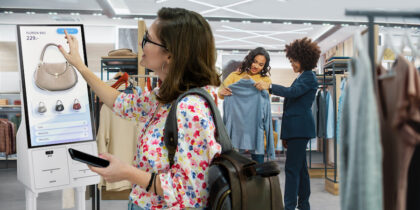From drawing consumers through the doors to delivering visual excitement and helpful information, retailers are using a variety of digital signage technologies to provide positive customer experiences and drive their business goals.
Easily updated screens are a better way of offering basic retail messaging, but digital displays are now being used by retailers to do more. Here are five ways that digital signage can influence the shopper’s journey.
1. Impactful first impressions
It’s a simple formula for any brick and mortar retailer: More foot traffic equals more sales. So making a strong first impression is critical, and it starts with what potential customers see outside: a shop’s windows.
Visual merchandising — what used to be called window dressing — is an art form among the world’s top retailers. Compelling design work in the windows of big department stores and luxury retailers make statements about the brand’s personality and ideally draw shoppers inside.
But for every big department store or flagship, there are countless mainstream retailers who also want and need to generate foot traffic. They may not have the resources for gallery-like window displays, but they can use digital display technology to make a difference.
The key is displays with the brightness and underlying engineering to cut through direct midday sunlight. The conventional screens used inside a store will be washed out and unviewable if set in windows.
Screens in windows can take a variety of forms:
- Super-bright screens that take the place of sales promotion and call-to-action posters
- Screens that complement a window’s thematic visual merchandising, such as video highlighting the key attributes of the product beside it
- Window-filling LCD or LED video walls that generate visual excitement or tell the brand story
2. Always-on-time visuals
If your routine takes you into quick-service restaurants (QSRs), you’ve likely noticed the menus behind the counter have almost all converted from print to digital.
Food service operators converted to digital menu displays for their timeliness and accuracy, and because adding moving, mouth-watering visuals to menus can boost sales.
Enhance the buyer's journey with digital signage
Get your free guide to the what, where and how of digital signage in retail environments. Download Now
But the restaurant business is not the only retail service that has lists of products and services that need to be conveyed to customers. Menu displays make sense in everything from salons to automotive service shops.
Here’s why they’re a better option:
- Speed and ease: Updating menus can take weeks to get designed, approved, printed, shipped and mounted. Digital menus can be changed with a few keystrokes and mouse clicks, and even automated when using templates and integrated data.
- Timeliness: Different menus by time of day is a fact of life in all-day restaurants, but other types of retail operators know customer interests and options can change by time of day or day of the week. Variable menus are easily scheduled using digital signage.
- Motion matters: Adding subtle motion and simple visuals can have a big impact on consumers. For example, controlled testing at an Atlanta store revealed a dramatic sales bump when static menus added images, particularly with motion.
3. Breathtaking retail landscapes
Feeling the pressure of hyper-competition from other brick and mortar and online retailers, savvy retailers are understanding the key to survival and growth is in delivering the kinds of customer experiences that draw shoppers and nurture loyalty.
Great retail experiences can be defined in many ways, but one of the keys is the way a store looks. Digital signage displays have been used as a sales tool for many years in retail, but now they’re being factored in as a core design feature.
In the past, an LCD video wall might have been used as one of several visual features around a store. Now, notably in a retailer’s flagship location, a video wall is the key wall in the store, using direct view LED technology as well as state-of-the-art microLED. Simply (and aptly) called The Wall, Samsung’s super-fine microLED product uses millions of additional LED lights — with each one being a single pixel — to create the ultimate, immersive viewing experience for shoppers.
Fine pixel pitch LED technology has several key attributes that excite retail store designers:
- No seams: Unlike LCD video walls, which necessarily have thin seams between units, LED walls are smooth, unbroken visual canvases.
- Few restrictions: LED video walls can conform to most architectural dimensions and surfaces. They can be as wide, narrow or tall as needed. They work with gentle curves, wrap around structural columns, and can even function as ceilings.
- Bright beacons: LED overpowers in-store lighting and bright sunlight, ensuring rich visuals in any conditions. It also is unaffected by reflection — often a problem for LCD displays.
- Flexibility: A wide variety of pixel pitches (the amount of light pixels per display unit) and structural designs means LED video walls can be matched to the location, viewing distances and budgets — from wider pitches to The Wall.
4. Look, lift and learn
Technology advances have made it not only possible but inexpensive and relatively easy to add intelligence to everyday devices and actions.
Clever retail merchandisers and brand strategists are tying sensors together with digital displays to make otherwise static product displays interactive and engaging.
For example, a beauty brand with multiple products that all look similar — but have different features and benefits — can use a lift and learn display to help inform consumers. A merchandising display in aisles or on shop counters can combine product, print, screens and sensors to deliver an experience that triggers an explanatory video whenever a product is lifted up by a shopper.
In a busy retail environment where there may be more browsers than sales staff, digital can accurately do the work of explaining why consumers want and need a product. Moreover, touchscreen displays like self-service kiosks allow shoppers to explore each product available as well as check out without any closeup interaction.
5. Sumptuous screens
With 4K screens, crisp visuals are available for marketers and viewers — but 8K displays are taking in-store messaging to new heights, showing products in their best possible light.
An 8K display has four times the total number of pixels of a 4K display, providing incredible levels of crisp detail. That can matter for luxury brands — from jewels and timepieces to cars and SUVs — that compete on quality and precision.
Even if brand marketers don’t have video material produced in 8K, they can effectively use those additional pixels if the displays have the right technology. Samsung has developed artificial intelligence (AI)-driven upscaling that uses machine learning to transform lower resolution visuals into vivid 8K.
Normally, lower resolution content — like full HD — played out on an 8K screen would cause blurring as the visuals stretch across all the pixels. But Samsung’s built-in AI technology, common across its 8K lineup, intelligently compensates and sharpens visuals to optimize how they look.
Couple that with Quantum Dots — nanoparticle technology that produces more than a billion distinct colors — and High Dynamic Range (HDR), which allows viewers to see all the subtle hues in both dark and extra-bright visuals, and retailers have visuals that can truly move consumers.
A holistic digital experience
Shopping is no longer a chore for people — even items like groceries and cars can be bought online and delivered to homes. That means retailers have to work harder at delivering the kind of shopping experience that not only brings people in but keeps them coming back. Digital signage technology is key to innovative retailing.
Reinvent the retail experience with Samsung’s in store digital signage. Or sign up to download the ultimate guide to high-brightness displays to deliver clear, compelling communications in any weather.







